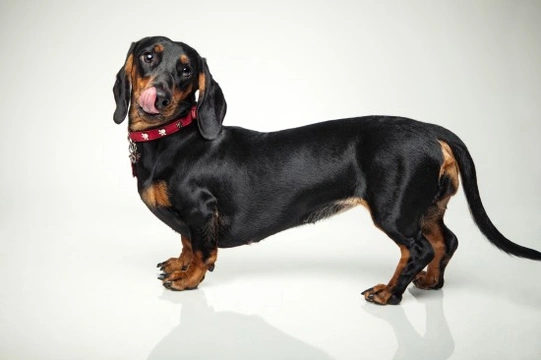
Dachshund paralysis and how to deal with it
The Dachshund or “sausage dog” has a rather unusual conformation when compared to most other canines, due to their long bodies in relation to their very short legs. While you might assume that this is the result of selective vanity breeding to achieve this rather unusual look, the Dachshund is not historically a lapdog or toy dog, but in fact used to fulfil a rather bold working role; pursuing badgers and other burrowing pests under the ground into their setts in order to assist with pest control. Their long bodies, short legs and fearless natures made this possible, but today, the Dachshund is almost exclusively kept as a domestic pet only.
However, because of the unique shape of the Dachshund and the length of their backs which gives them their “sausage dog” nickname, the Dachshund breed as a whole is prone to problems with their backs and spines, which can manifest in a variety of different ways.
Dachshunds are particularly prone to developing intervertebral disc disease, which is a condition that occurs when some of the discs of the spine become damaged, and press on the spinal cord itself. A variety of other conditions such as injuries to the back or infections and inflammations of the spine can also lead to problems, up to and including paralysis, which may be either temporary or permanent.
If you own or are considering getting a Dachshund, it is very important to be aware of the potential spinal problems that they can develop, and to do what you can to find out about how to identify and deal with back problems and paralysis. Read on to learn more about Dachshund paralysis, and how to deal with it.
What to do if you identify a problem
If your Dachshund of any age begins to show the potential signs of back problems, such as weakness in the spine or hind limbs or obvious paralysis, arrange an appointment with your vet immediately. Issues such as these in the Dachshund will not resolve themselves on their own, and the sooner that you seek advice on how to manage or treat the condition, the best chance your dog will have of maintaining a good quality of life.
Paralysis of the spine or rear limbs can lead to a whole range of problems, including issues with going to the toilet; your dog may display either faecal or urinary incontinence (or both) or be unable to go to the toilet on their own, either of which are serious issues that you will need your vet’s help to manage.
Managing paralysis
Assuming that your vet agrees that your dog can maintain a good quality of life despite their paralysis, you will likely need to invest in a few items of kit to keep your dog mobile and help to keep them in good condition. Some paralysed Dachshunds maintain their mobility by the use of a wheeled, supporting cart to carry their hind legs, which may need to be specially ordered or even made to fit your dog. This course of action is not considered to be viable for all Dachshunds with paralysis, however, so you should follow your vet’s guidance on how to proceed.
You should prepare a safe, comfortable area for your dog to sleep and rest in, preferably one that is enclosed to limit your dog’s movement when you are not around, as your dog may get into difficulties or injure themselves by trying to drag their immobile hind legs around.
One of the main problems that arises regarding the day to day management of Dachshund paralysis is the development of pressure sores on contact areas that touch the ground, particularly areas that your dog drags around or that are supported by a mobility cart. The early signs of pressure sores include loss of hair, red or inflamed skin, and broken sore areas. These will need ongoing treatment and management to prevent infection and promote healing.
Toileting
Dogs with paralysed hind limbs may, as mentioned, have problems holding their bladder or bowels, and so incontinence is a common problem among paralysed dogs. It is important to clean up any urine or faeces promptly and check your dog regularly to ensure that they are not sitting in their own muck, as this is of course unhygienic and can also lead to sores and irritations of the skin.
Some paralysed dogs are not able to toilet on their own, and if this is the case, your vet will need to teach you the correct process to manually express the bladder and bowels, and you must schedule this into your dog’s daily routine at the appropriate times to take care of their needs.
Physical considerations
If the paralysis is partial, temporary or potentially reversible, your vet may well recommend a course of physiotherapy on your dog, and this is something that you can also take care of at home. You should massage and flex the affected limbs daily in order to keep them supple and promote healing, and to check your dog’s condition for any worsening or improvement.
Taking care of a physically disabled dog can be challenging, time consuming and expensive, and it is not appropriate for every dog or every owner. You will need to work closely with your vet to assess your dog’s quality of life on an ongoing basis, and ensure that your dog is happy, and that both of you are coping well.



